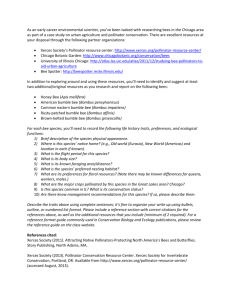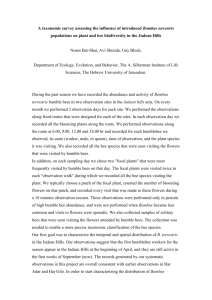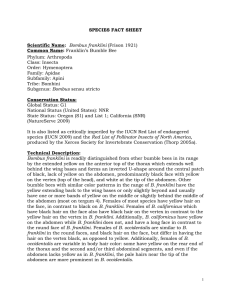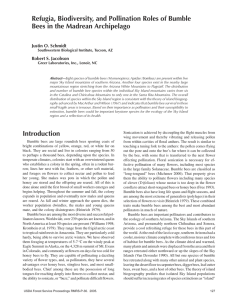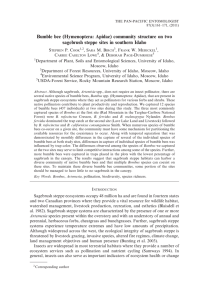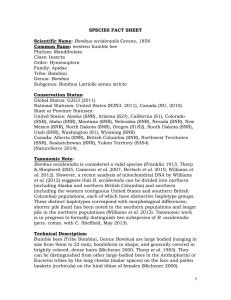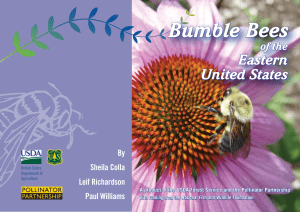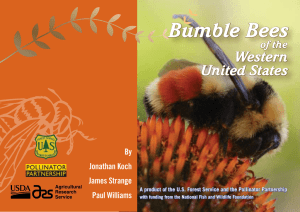The Status of the Bees
advertisement
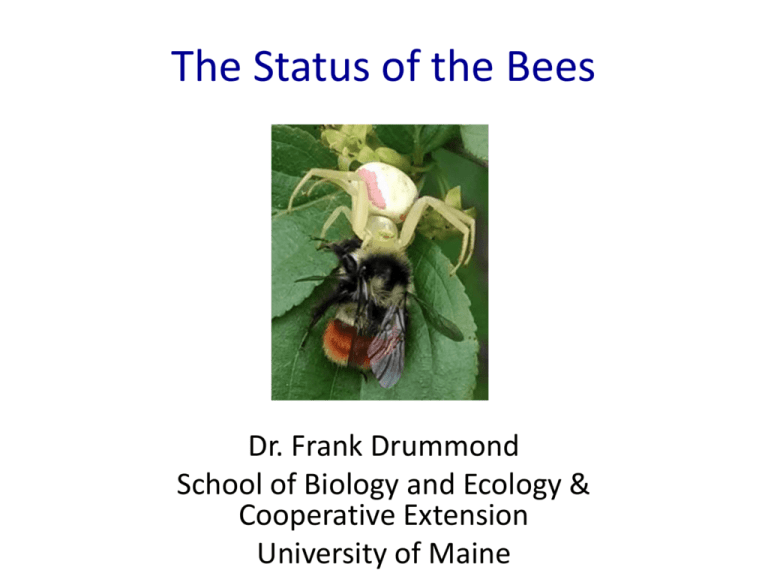
The Status of the Bees Dr. Frank Drummond School of Biology and Ecology & Cooperative Extension University of Maine bee diversity • • • • • • Worldwide – 20,000 species U.S. – 2,500 species Florida, Arizona – 700 species New York – 450 species Massachusetts – 350-400 Maine – 275 species where do we stand… honeybees Maine brings in almost 85,000 colonies per year just for wild blueberry! Three Maine research projects on honeybees since 2009 Seattle Olympia Washington Maine Montana Salem 1. North Dakota Helena Oregon Bismarck Idaho Boise Wyoming Sacramento Carson City Nevada Cheyenne Salt Lake City Utah San Francisco Denver Colorado California Las Vegas Augusta Minnesota Montpelier N.H. Vt. Concord St. Paul Boston Albany Michigan South Dakota Mass. Wisconsin Providence New York Pierre Lansing Madison Hartford R.I. Conn. Detroit New York Pennsylvania Chicago Iowa Philadelphia Trenton New Jersey Nebraska Harrisburg Dover Des Moines Ohio Lincoln Md. Delaware Indiana Illinois Columbus West Annapolis Virginia Indianapolis Washington, D.C. Springfield Richmond Topeka St. Louis Charleston Virginia Frankfort Kansas Jefferson City Missouri Kentucky Raleigh Nashville Santa Fe Los Angeles Arizona Phoenix New Mexico North Carolina Tennessee Oklahoma Oklahoma City Arkansas Memphis Atlanta Little Rock Mississippi Dallas Columbia Alabama Montgomery South Carolina Georgia Jackson Louisiana Texas Austin Houston Tallahassee Baton Rouge New Orleans Florida Miami 1. National stationary hive project (2009-2013) 2. Effect of fungicide propiconazole (2011-2013) 2. 3. Health of honeybee colonies on Maine blueberry barrens (2014-2015) 3. Seattle Olympia Washington Maine Montana Salem North Dakota Helena Oregon Minnesota Carson City Nevada Cheyenne Nebraska Lincoln Denver Topeka Colorado California Michigan Wisconsin Pierre Salt Lake City Utah San Francisco Montpelier N.H. Vt. Concord Boston Albany Mass. Providence Lansing Madison Hartford R.I. Conn. Detroit New York Pennsylvania Chicago Iowa Philadelphia Trenton New Jersey Harrisburg Dover Des Moines Ohio Md. Delaware Indiana Illinois Columbus West Annapolis Virginia Indianapolis Washington, D.C. Springfield Richmond St. Louis Charleston Virginia Frankfort Jefferson City St. Paul South Dakota Wyoming Sacramento Augusta Bismarck Idaho Boise Kansas Las Vegas New York Missouri Kentucky Raleigh Nashville Santa Fe Los Angeles Arizona Phoenix Oklahoma City New Mexico North Carolina Tennessee Oklahoma Arkansas Memphis Mississippi Dallas Columbia Atlanta Little Rock Alabama Montgomery South Carolina Georgia Jackson spring 2009 – spring 2013 colony losses (all trials and all sites, n = 442 colonies) Louisiana Texas Austin Houston Tallahassee Baton Rouge New Orleans Florida Miami • 2009 - 2013 colony loss Year*** Apiary site*** Varroa*** Varroa x site*** Nosema** Nosema x site* IAPV* P = 0.0006 P < 0.0001 P < 0.0001 P = 0.0003 P < 0.007 P = 0.021 P = 0.054 relative risk 4.9 2.1 1.3 effect of intensive agriculture? factors that affect colony loses • • • • • Varroa destructor (1986) Nosema ceranae (1990) Viruses – new and old Overall geographic location (weather, forage) Pesticides – acute, but also subtle sublethal effects what’s new and emerging? ZOMBIE BEES (2012) how are the wild bees? • • • • species declines exotics ? species shifts species rebounds A. Dibble very, very difficult to measure ! another factor that makes it difficult declines HAVE been documented around the globe Declines in the Northeast… Historical trends in Maine rusty patch bumble bee Colla and Packer 2008, images: Xerces Society, Sam Droege the decline of the yellow banded bumble bee in Maine 2013 survey for the yellow banded bumble bee, Bombus terricola Observed and confirmed NOT observed 1. survey sites in Maine (n=29 confirmed) 2. percent occurrence = 13.8 % (n=29) 3. relative abundance = 2.4% (n=18), compared to 1-2% from 2009-2012. 2014 survey for the yellow banded bumble bee, Bombus terricola Observed and confirmed Reported, but NOT confirmed NOT observed 1. survey sites in Maine and New Brunswick (n=87 confirmed) 2. percent occurrence = 49.4 % (n=87) 0% in NH 2014 survey (9 locations, n = 1349 bees collected, Rehan data) 3. relative abundance = 7.4% (n=18), compared to 1-2% from 2009-2013. 4. occurrence vs Bombus richness, ns (P = 0.13, n=18) 2015 survey for the yellow banded bumble bee, Bombus terricola Observed and confirmed Reported, but NOT confirmed NOT observed 1. survey sites in Maine and New Brunswick (n=52 confirmed) 2. percent occurrence = 61.5 % (n=52) 3. relative abundance = 11.5.4% (n=32), compared to 1-2% from 20092013. 4. occurrence vs Bombus richness, ns (P = 0.08, n=32) factors affecting declines • • • • climate change? habitat fragmentation and shrinking habitat pesticides pathogens & parasites – native pathogens and new stressors – exotic new pathogens? • genetic diversity (bees – low diversity due to breeding system and inbreeding) • exotic bees – competition ? pesticides bumble bees in Maine Kalyn Bickerman PhD Student University of Maine School of Biology and Ecology bumble bees and imidacloprid revisited (2013 & 2014) parasites and disease • native • exotic … aka SPILLOVER a native bumble bee pathogen Fungal pathogen Nosema bombi Spread through spores N. Bombi spores, 1000X. Bickerman, 2012 Prevalence species-dependent No effect - commercial bumble bees Bushmann et al. (2013) Bickerman and Drummond, unpublished data spill-over of pathogens from honey bees to native bees? Table 5. Percentage of virus-positive Bombus sampled from flowers in the vicinity of Stationary Apiaries in Maine, Minnesota, and Washington. Samples were taken in July/August 2010. DWV = Deformed wing virus and BQCV = Black queen shared Bombus cell virus. Apiary and Single Single Dual infection Species infection infection n DWV BQCV DWV + BQCV MAINE Bombus ternarius Bombus vagans Bombus spp. Mean MINNESOTA Bombus bimaculatus Bombus impatiens Bombus vagans Mean WASHINGTON Bombus mixtus Bombus spp. Mean 26 5 8 73.1 80.0 87.5 79.4 38.5 40.0 62.5 43.6 30.7 20.0 62.5 35.9 5 20.0 40.0 20.0 7 5 85.7 80.0 64.7 85.7 100 76.5 71.4 80.0 58.8 11 18 81.8 72.2 75.9 90.9 94.4 93.1 72.7 72.2 72.5 pathogen spill-over? why the honey bee? • Only bees (and a few aphids) make honey • Honey bee stores large quantities of honey • Stingless bees also store honey in Australia, Asia, Africa and Central and South America • In the U.S. ? Amy Campbell
